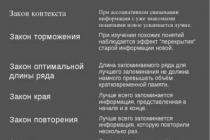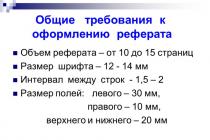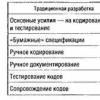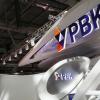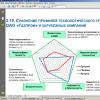Production costs (cost) is expressed in monetary terms current expenses firms for the production and sale of products, which are the estimated price base
Calculation unit- this is a unit of a specific product (service) according to costing items (according to costing)
The basis for calculating prices is costing (distribution costs).
It is compiled for the unit of measurement of the quantity of manufactured products adopted taking into account the specifics of production (1 meter, 1 piece, 100 pieces, if produced at the same time). The calculation unit can also be the unit of the leading consumer parameter of the product.
Lists of costing items reflect the features of production.
For modern domestic practice, the following list of costing items can be considered the most characteristic:
- raw materials and supplies;
- fuel and energy for technological purposes;
- wages of production workers;
- charges for wages production workers;
- overhead costs;
- general running costs;
- other production expenses;
- business expenses.
Items 1-7 are called production costs, as they are directly related to maintenance production process. Sum production costs is production cost . Article 8 (sales expenses) expenses associated with the sale of products: expenses for packaging, advertising, storage, partially fare. The sum of production and selling expenses is total cost of production. There are direct and indirect costs. Direct costs relate directly
on the cost of a particular product. According to the above list, direct costs are represented by items 1-3, which is typical for most industries. indirect costs are usually associated with the production of all products or several of its types and are indirectly related to the cost of specific products - using coefficients or percentages. Depending on the specifics of production, both direct and indirect costs can vary greatly. For example, in mono-production, direct costs are almost all costs, since the result of production is the release of one product (ship building, aircraft building, etc.). On the contrary, in hardware processes ( chemical industry), where a gamut of other substances is obtained simultaneously from one substance, almost all costs are indirect.
There are also conditionally constant and semi-variable expenses. conditionally permanent called costs, the volume of which does not change or changes slightly with a change in the volume of output. For the vast majority of industries, general production and general business expenses can be considered as such. conditional variables consider the costs, the volume of which is directly proportional to the change in the volume of output. Usually these are material, fuel and energy costs for technological purposes, labor costs with accruals. The specific list of costs, as we have already said, depends on the specifics of production.
Manufacturer's profit in price - the amount of profit, minus indirect taxes, received by the manufacturer from the sale of a unit of goods.
If the prices of goods are free, then the amount of this profit depends directly on pricing strategy manufacturer-seller (chapter 4).
If prices are regulated, then the amount of profit is determined by the rate of return established by the authorities, and with the help of other levers of direct price regulation (Chapter 2).
In modern Russian conditions the objects of direct price regulation at the federal level are the prices for natural gas for monopoly associations, electricity tariffs regulated by the Federal Energy Commission Russian Federation, tariffs for the types of transport with the largest freight turnover (primarily tariffs for freight rail transport), the price of vital drugs and services that are most significant from the economic and social standpoints.
The object of direct price regulation by the constituent entities of the Russian Federation and local authorities is a much wider list of goods and services. This list depends to a decisive extent on two factors: the degree of social tension and the possibilities of regional and local budgets. The higher the social tension and the larger the amount of budgetary funds, the more equal conditions greater scale of direct price regulation.
IN Russian practice under state regulation of prices and in the overwhelming majority of cases under a system of free prices, the full cost of a unit of goods is taken into account as the basis for using the percentage of profitability in calculating profits.
Example. The cost structure for costing items per 1000 products is as follows:
- Raw materials and basic materials - 3000 rubles.
- Fuel and electricity for technological purposes - 1500 rubles.
- Remuneration of the main production workers - 2000 rubles.
- Accruals for wages - 40% of the wages of the main production workers
- General production expenses - 10% of the wages of the main production workers.
- General business expenses - 20% of the wages of the main production workers.
- The cost of transportation and packaging - 5% of the production cost.
It is necessary to determine the level of the manufacturer's price for one product and the amount of profit from the sale of one product, if the profitability acceptable to the manufacturer is 15%.
Calculation
1. We calculate in absolute terms indirect costs, given as a percentage of the wages of the main production workers, per 1000 products:
- accruals for wages = 2000 rubles. *40% : 100% = 800 rubles;
- overhead costs \u003d 2000 rubles. *10% : 100% = 200 rubles;
- general expenses = 2000 rubles. *20% : 100% = 400 RUB
2. We define the production cost as the sum of the costs of articles 1-6.
- Production cost of 1000 items = 3000 + 1500 + 2000 + 800 + 200 + 400 = 7900 (rubles).
3. Costs for transportation and packaging = 7900 rubles. 5%: 100% = 395 rubles.
4. Full cost of 1000 products = 7900 rubles. + 395 rub. = 8295 rubles; total cost of one product = 8.3 rubles.
5. Manufacturer's price for one product = 8.3 rubles. + 8.3 rubles. 15%: 100% = 9.5 rubles.
6. Including profit from the sale of one product = 8.3 rubles. 15%: 100% = 1.2 rubles.
Manufacturer price- the price, including the cost and profit of the manufacturer.
Actual sale of goods (services) according to manufacturer's prices(manufacturer's price, factory price) is possible mainly when there are no indirect taxes in the price structure. In modern economic practice, the list of such goods (services) is limited. As a rule, indirect taxes are present in the price structure as direct pricing elements. In absolute prices
most goods (services) included value added tax(VAT).
The structure of prices for a number of goods contains excise. This indirect tax is included in the price of goods that are characterized by inelastic demand, i.e., an increase in the price level as a result of the inclusion of an excise in it does not lead to a decrease in the volume of purchases this product. Thus, the fiscal tax function is implemented - ensuring budget revenues. At the same time, excisable goods should not be essential goods: the introduction of an excise tax in this case would be contrary to the requirements social policy. In this regard, both in domestic and international practice, excisable goods are primarily alcoholic products And tobacco products. Goods such as sugar and matches, which are characterized by the highest degree of demand inelasticity, are not excisable, since they are included in the list of essential goods.
Along with the main federal taxes (value added tax and excise), prices may include other indirect taxes. For example, before 1997 in Russia, a special tax was included in the price structure. In 1999 sales tax was introduced in almost all regions of the Russian Federation. Later, these indirect taxes were removed.
Let us dwell on the methodology for calculating the value of value added tax in the price as the most common tax.
The price without VAT is the basis for calculating value added tax. VAT rates are set as a percentage of this base.
Example. Manufacturer price level -
9.5 rub. for one product. The value added tax rate is 20%. Then the level of the selling price, i.e., the price exceeding the manufacturer's price by the amount of VAT, will be:
- Tsotp \u003d Cizg + VAT \u003d 9.5 rubles. + 9.5 rubles. 20%: 100% = 11.4 rubles.
Elements of the price are also intermediary wholesale markup And trade allowance, if the product is sold through .
Selling price- the price at which the manufacturer sells products outside the enterprise.
The selling price exceeds the manufacturer's price by the amount of indirect taxes.
Rules for accounting and regulation of intermediary services
Intermediary (trade) allowance (discount)- the form of price compensation of the wholesale (trading) intermediary.
Distribution costs- the intermediary's own costs, excluding the costs of the purchased goods.
Both the wholesale intermediary and trade markups, by economic nature, as noted in Chapter 2, are the prices of services of the intermediary and trade organizations, respectively.
Like any price, an intermediary price reward contains three elements:
- intermediary costs or distribution costs;
- profit;
- indirect taxes.

Rice. 9. General price structure in modern Russian conditions. Ip - production costs (cost); П - profit; Hk - indirect taxes included in the price structure; Nposr - wholesale intermediary allowance.
As competition develops, the chain of intermediaries decreases. Currently in domestic practice a wide range of consumer goods is sold only with the help of reseller and straight from the manufacturer.
In business practice brokerage fee can be calculated in the form allowances And discounts.
In absolute terms, the intermediary discount and surcharge are the same, since they are calculated as the difference between the price at which the intermediary purchases the goods - purchase price, and the price at which it sells - selling price. The difference between the concepts of "discount" and "surcharge" appears if they are given in percentage terms: the 100% base for calculating the markup is the price at which the intermediary purchases the goods, and the 100% base for calculating the discount is the price at which the intermediary sells this product.
Example.
- The intermediary purchases goods at a price of 11.4 rubles. and sells it at a price of 13 rubles.
- In absolute terms, discount = surcharge = 13 rubles. - 11.4 rubles. = 1.6 rubles.
- The percentage of the allowance is 1.6 rubles. · 100%: 11.4 rubles. = 14%, and the discount percentage is 1.6 rubles. · 100% : 13 rub. = 12.3%.
Under conditions of free prices, intermediary allowances are used when the seller does not experience hard price pressure, i.e., takes the position of a monopolist (leader) in the market. In such a situation, the seller has the opportunity to directly add remuneration for intermediary services.
However, more often intermediary allowances are used as a lever of price regulation by the authorities, when market conditions allow selling goods at a price higher than allowed by the interests of national economic and social policy. So, in Russia for a long time supply and marketing allowances were applied to the most important species fuel. These allowances were regulated by federal authorities. At present, in almost all regions of Russia there are trade allowances for products of increased social importance. These allowances are regulated local authorities authorities. The scale of their use increased significantly after the 1998 crisis.
Under conditions of free prices, intermediary discounts are used when the seller is forced to calculate his indicators in strict dependence on the prices prevailing in the market. In this case, the calculation of the intermediary's remuneration is based on the principle of "discarding" this remuneration from the level of the market price.
Intermediary discounts are usually provided by manufacturers to sales intermediaries and their permanent representatives.
Along with intermediary discounts and surcharges associated with the price level, a wide
such a form of remuneration for an intermediary as establishing for him percent of the cost of goods sold.
The profit of the intermediary is determined using the percentage of profitability to distribution costs. Distribution costs- the intermediary's own costs (for example, rent for premises, labor costs, packaging and storage of goods).
The costs associated with the purchase of goods are not included in the distribution costs.
Example. Taking into account the conditions of the previous example, we determine the maximum allowable distribution costs for an intermediary if the minimum acceptable profitability for him is 15%, and the VAT rate for intermediary services is 20%.
We can represent the absolute value of the intermediary remuneration by an equation, taking for x the maximum allowable distribution costs:
- x + x * 0.15 + (x + 0.15x) * 0.2 = 1.6;
- x = 1.16 (rubles).
If the sale of goods is accompanied by the services of not one, but several intermediaries, then the percentage of the markup of each subsequent intermediary is calculated on the price of its purchase.
Example. The intermediary sells the goods trade organization. Subject to the above conditions, this sale will be carried out at a price of 13 rubles. (11.4 + 1.6).
Then the retail price at the maximum allowable level trade allowance in 20% will be 15.6 rubles. (13 + 0.2 * 13).
Intermediary discounts and surcharges must be distinguished from price discounts And allowances.
The former, as mentioned above, constitute remuneration for intermediary services, therefore their presence is always associated not with one, but with several price stages (their number is directly proportional to the number of intermediaries).
Price discounts and markups are sales promotion tools (Chapter 4). They are used in relation to one price level and are associated with one price stage.
The general structure of the price in modern Russian conditions, taking into account all of the above elements, is shown in fig. 9.
Pricing is an important process in the economy. The process of price formation is inextricably linked with all the processes taking place in the market. In this process, it is important to establish marginal values that determine the price level and above which it cannot be set. This is the function of price regulation by the state.
The purpose of price regulation is to ensure effective work economic system. Proper regulation makes it possible to contain the prices of products produced by monopolists.
The state pays special attention to those sectors where it affects the well-being of the population. These include the following groups of goods and services:
- natural gas;
- tariffs for housing and communal services;
- transportation services;
- mail forwarding and electronic communication services.
Methods of price regulation
There are two types of influence government agencies on pricing: indirect and direct. The direct method of influence includes the following methods:
- fixing a fixed price for goods;
- marginal price calculation;
- calculation of the marginal level of profitability;
- determination of a fixed amount of allowances;
- price declaration.
Marginal as a way to regulate prices
 Marginal profitability is understood as the highest percentage of product profitability that is allowed by the state when pricing goods and services. It is calculated as a percentage of the cost of production.
Marginal profitability is understood as the highest percentage of product profitability that is allowed by the state when pricing goods and services. It is calculated as a percentage of the cost of production.
This type of regulation allows the state to dictate to monopolists the amount of profit as part of the price of products. The value of marginal profitability is based on the cost of resources involved in the production of goods of each individual enterprise.
Thus, the establishment of the value of the marginal profitability for monopolist enterprises located in state register allows you to control the prices of their products.
Depending on the purpose of the goods, the percentage of marginal profitability can range from 5 to 40%.
Which products are not eligible for marginal profitability?
At the legislative level, a list of goods and services is fixed, which are not subject to marginal profitability. In such a list are:
- products of enterprises and companies, the prices for which are determined based on the current legislation;
- products manufactured using high-tech and energy-efficient equipment, as well as various inventions used specifically in the production of this type of product. In this case, price regulation using marginal profitability is not carried out for three years from the start of production;
- for products manufactured by enterprises where more than 50% of employees are people with limited legal capacity. The founders of these enterprises are United Organizations of the Disabled;
- For new goods and services for a period of up to one year from the moment they are put into production and until they are put on the market.
Responsibility of enterprises for pricing violations
 In Russia, there are a number of laws and regulations according to which violation of the pricing procedure leads to the application of various economic sanctions. Overestimation of the percentage of marginal profitability refers to a violation state regulation cost.
In Russia, there are a number of laws and regulations according to which violation of the pricing procedure leads to the application of various economic sanctions. Overestimation of the percentage of marginal profitability refers to a violation state regulation cost.
To identify various violations there are a number of government agencies. The entire amount of profit received in excess of the permitted level is subject to withdrawal in.
Enterprises that, based on the results of their own audit of their activities, have identified excess profits and independently made its deductions to the budget, are exempt from economic sanctions and fines. At the same time, there should be a decrease in the cost of goods and services in accordance with the recommendations of government agencies.
Stay up to date with all important United Traders events - subscribe to our
 To analyze and calculate the effectiveness of the enterprise, a wide range of economic and financial indicators. They differ in the complexity of the calculation, the availability of data, and the usefulness for analysis.
To analyze and calculate the effectiveness of the enterprise, a wide range of economic and financial indicators. They differ in the complexity of the calculation, the availability of data, and the usefulness for analysis.
Profitability is one of the best performance indicators - ease of calculation, data availability and great usefulness for analysis make this indicator mandatory for calculation.
What is the profitability of the enterprise
Profitability (RO - returnon)- overall score economic efficiency activities of the enterprise or the use of capital / resources (material, financial, etc.). This indicator is necessary for the analysis economic activity and for comparison with other enterprises.
Profitability, unlike profit, is a relative indicator, so the profitability of several enterprises can be compared with each other.
Profit, revenue and sales are absolute figures or economic effect and it is incorrect to compare these data of several enterprises, because such a comparison will not show the true state of affairs.
It is possible that an enterprise with a smaller sales volume will be more efficient and sustainable, that is, it will outperform another enterprise in terms of relative indicators, which is more important. Profitability is also compared to efficiency(efficiency factor).
In general terms, profitability shows how many rubles (kopecks) of profit one ruble invested in assets or resources will bring. For the profitability of sales, the formula reads as follows: how many kopecks of profit are contained in one ruble of revenue. Measured as a percentage, this indicator reflects the effectiveness of the activity.
There are several main types of profitability:
- profitability of products / sales (ROTR / ROS - totalrevenue / sale),
- return on cost (ROTC - total cost),
- return on assets (ROA - assets)
- return on investment (ROI - invested capital)
- personnel profitability (ROL – labor)
The universal formula for calculating profitability is as follows:
RO=(Type of profit/Indicator whose profitability needs to be calculated)*100%
In the numerator, the type of profit is most often used profit from sales (from sales) and net profit, but it is possible to calculate , balance sheet profit and . All types of profits can be found in the report on financial results(on profit and loss).
The denominator is the indicator whose profitability needs to be calculated. The indicator is always in value terms. For example, to find the return on sales (ROTR), that is, the denominator should be an indicator of sales in value terms - this is revenue (TR - totalrevenue). Revenue is found as the product of price (P - price) and sales volume (Q - quantity). TR=P*Q.
The formula for calculating the profitability of production
Return on cost (ROTC - returnontotalcost)- one of the main types of profitability required for efficiency analysis. Return on cost is also called the profitability of production, as this indicator reflects the efficiency of the production process.
Profitability of production (cost) is calculated by the following formula:
ROTC=(PR/TC)*100%
In the numerator, profit from sales / sales (PR), which is found as the difference between income (revenue - TR - totalrevenue) and expenses (total cost - TC - totalcost). PR=TR-TC.
In the denominator, the indicator whose profitability needs to be found is the total cost (TC). The full cost consists of all the costs of the enterprise: the cost of materials, semi-finished products, the wages of workers and AUP (administrative and managerial personnel), electricity and other housing and communal services, workshop and factory costs, advertising costs, security, etc.
The largest share in the cost is materials, so the main production is called material-intensive.
Profitability of the cost price shows how many kopecks of profit from the sale will bring one ruble invested in the cost of production. Or, measured as a percentage, this indicator reflects the percentage of efficient use of production resources.
Balance sheet profitability formula
Many types of profitability are calculated on the basis of balance sheet data. The balance sheet contains information about the assets, liabilities and equity of the organization.
Compiled given form 2 times a year, that is, the status of any indicator can be viewed at the beginning of the period and at the end of the period. To calculate the profitability from the balance sheet, the following indicators are required:
- assets (current and non-current);
- the amount of own capital;
- investment size;
- and etc.
You can’t just take any of these indicators and calculate the profitability - this is wrong!
In order to correctly calculate the profitability, you need to find the arithmetic mean of the sum of the indicator at the beginning of the current (end of the previous) and the end of the current period.
For example, find the profitability of non-current assets. From the balance sheet, the sum of non-current assets at the beginning and end of the period is taken and divided in half.
In the balance sheet of medium-sized enterprises, the value of non-current assets is reflected in line 190 - Total for section I, for small enterprises, the value of non-current assets is the sum of lines 1150 + 1170.
The formula for the profitability of non-current assets is as follows:
ROA (in) \u003d (PR / (VnA np + VnA kp) / 2) * 100%,
where VnA np is the value of non-current assets at the beginning of the current (end of the previous) period, VnA kp is the value of non-current assets at the end of the current period.
The profitability of non-current assets shows how many kopecks of profit from sales will bring one ruble invested in non-current assets.
An example of calculating the profitability of production
To calculate the profitability of production, the following indicators are required: total cost (TC) and profit from sales (PR). The data are presented in the table.
PR 1 \u003d TR-TC \u003d 1500000-500000 \u003d 1,000,000 rubles
PR 2 \u003d TR-TC \u003d 2400000-1200000 \u003d 1,200,000 rubles
It is obvious that the revenue and profit from the sale of the second enterprise is higher. In terms of absolute indicators, the effect of the second enterprise is higher. But does this mean that the second enterprise is more efficient? For an answer to this question production is needed.
ROTC 1 =(PR/TC)*100%=(1000000/500000)*100%=200%
ROTC 2 =(PR/TC)*100%=(1200000/1200000)*100%=100%
The profitability of the production of the first enterprise is 2 times higher than the profitability of the production of the second enterprise. We can confidently say that the production of the first enterprise is 2 times more efficient than that of the second.
Profitability, as an indicator of the effectiveness of the enterprise, more accurately reflects the real state of affairs in production, sales or investment of the enterprise, allowing you to correctly respond to current situation, as opposed to using absolute numbers, which do not give the full picture.
Video about what shows profitability:
Return on profit is key indicator financial analysis, which allows you to understand whether the business pays for itself and how efficiently. You will need the calculation of this indicator for the qualitative preparation of a business plan, monitoring the dynamics of costs, for adjusting prices for products or services, as well as for an overall assessment of the profitability of your company in the analyzed period. Return on profit is usually expressed as a percentage, and the higher the percentage, the more profitable the business is.
Steps
Part 1
Calculation of profit margin- Think about why you need to calculate profitability? If you want to get approved for a loan or attract investors, then interested people will need to analyze the longer period of time your company has been operating. However, if you want to compare ROI from month to month for your own needs, then it is quite acceptable to take shorter monthly intervals for calculation.
-
Calculate total revenue received by your company in the analyzed period. Revenue is the total income of a company from the sale of goods or services.
- If you only sell products, for example, keep retail store, then your revenue for the analyzed period will be all realized sales minus discounts and product returns. If you don't have numbers ready to hand, then multiply the number of items sold by their price and adjust the result for discounts made and returns made.
- Similarly, if your company is engaged in the provision of services, such as repair and tailoring, then your revenue will be all the funds received for the provision of services in a particular period.
- Finally, if you keep investment company, then in the calculation of your income you must take into account interest income and dividends received.
-
For calculation net profit subtract all your expenses from your income. Costs are by nature the opposite of revenue. They represent the costs that you had to incur during the period in connection with the production of goods or services and the use of certain funds in your activities. Your expenses will include not only the cost, but also operating, investment and other types of expenses.
Divide your net income by revenue. The result of the division, expressed as a percentage, will be the net profit margin, namely, the percentage share of net profit in the company's revenue.
- For the above example, the calculation would look like this: (300,000 ÷ 1,000,000) *100% = 30%
- For the purpose of another explanation of the meaning of the profitability indicator, an example is the business of selling paintings. Profitability in this case will indicate what proportion of the money received for the sale of paintings covers costs and allows you to make a profit.
Part 2
Correct application of the profitability indicator-
Evaluate if the ROI value matches what your business needs. If you plan to live solely on income from your entrepreneurial activity, analyze the profitability and sales volumes that can usually be realized in a year. You will definitely want to spend part of the profits received on reinvesting in the business, so calculate whether you will have enough for habitual image life of what is left of the profit?
- For example, as mentioned above, the company's net profit amounted to 300,000 rubles out of 1,000,000 rubles of revenue. If 150,000 rubles are spent on reinvesting in a business, then you will have only 150,000 rubles left in your hands.
-
Compare your company's profit margin with those of other comparable companies. Other useful application profitability indicator is its use in the comparative analysis of comparable companies. If you want to get a loan from a bank for a company, then the bank employees will tell you what the profitability of your type of business should be, taking into account its size, in order to approve the loan. If you have enough big company, which has its own competitors, you can collect information about competitors and calculate their profitability to compare with yours.
- For example, Company 1 has a revenue of 5,000,000 rubles, and all expenses - 2,300,000 rubles, which gives a profitability of 54%.
- Company 2 has a revenue of 10,000,000 rubles and expenses of 5,800,000 rubles, so its profitability is 42%.
- In this situation, Company 1's margin is better, even though Company 2 earns twice as much revenue and has a higher net income.
-
When comparing profitability indicators, you should not "compare forks with bottles." The profitability of companies varies greatly depending on their size and industry. To get the most out of comparative analysis, it is best to compare two or more companies in the same industry that have roughly the same revenue.
-
If necessary, try to improve your company's profit margin. Profitability can be changed by increasing revenue (for example, by increasing prices or increasing sales) or by reducing the cost of doing business. In addition, even if after the actions taken to increase revenue and reduce costs, the value of profitability does not change, you will receive an increase in net profit in ruble terms. However, when experimenting with raising prices or lowering costs, remember to keep your business, risk tolerance, and competition in mind.
- It is usually necessary to make small changes before venturing into larger ones to avoid ruining the business or causing customer dissatisfaction. Keep in mind that increasing profitability comes at a price, and trying too aggressively to increase profitability can backfire on your business.
- In addition, profitability should not be confused with the sales margin. The trade margin is the difference between the selling price of a product and its cost.
Understand the difference between gross margin, gross profit margin and net income. Gross profit is the difference between the proceeds from the sale of goods or services and their cost. Its calculation does not take into account commercial, administrative and other expenses, only those costs that are directly related to the production of goods or the provision of services are taken into account. Gross profit margin is the ratio of gross profit to revenue.
Define the billing period. To calculate the profitability of profit, the first step is to determine the period to be analyzed. Usually, comparable months, quarters or years are taken for calculation and profitability is calculated for these periods.

